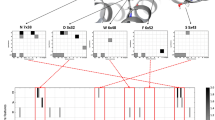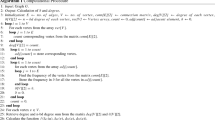Abstract
Molecular fingerprint indices are derived from Jacobi expansion of molecular electron density in a ball. Electron density computed in the linear combination of atomic orbitals framework, at any computational level, is expanded in terms of suitable Jacobi polynomials times regular spherical harmonics. The procedure is applicable to calculations with either Gaussian or Slater-type orbitals. A very efficient algorithm previously reported for Canterakis–Zernike expansions is shown to be also applicable for this type of expansions. The procedure has been implemented in the DAMQT suite for the analysis of electron density, which facilitates the application to densities obtained with standard packages for molecular structure calculations. Fingerprints derived from Jacobi expansions are compared with other derived from Canterakis–Zernike expansions in some pharmacological molecules.






Similar content being viewed by others
References
Amat L, Carbó-Dorca R (2000) J Chem Inf Comput Sci 40(5):1188. https://doi.org/10.1021/ci0000272
Bultinck P, Carbó-Dorca R (2005) J Chem Sci 117(5):425. https://doi.org/10.1007/BF02708346
Carbó-Dorca R (2012) J Math Chem 50(4):734. https://doi.org/10.1007/s10910-011-9920-6
Carbó-Dorca R (2012) J Math Chem 50(2):2339
Carbó-Dorca R, Besalú E (2012) J Math Chem 50(1):210. https://doi.org/10.1007/s10910-011-9906-4
Carbó-Dorca R, Besalú E (2013) J Math Chem 51(1):382. https://doi.org/10.1007/s10910-012-0089-4
Carbó-Dorca R (2013) J Math Chem 51(2):413. https://doi.org/10.1007/s10910-012-0091-x
Mezey P (1995) Methods of molecular shape similarity and topological shape design. In: Dean PM (ed) Molecular similarity in drug design. Springer, Dordrecht. https://doi.org/10.1007/978-94-011-1350-2_10
Carbó R (1995) Molecular similarity and reactivity: from quantum chemical to phenomenological approache. Kluwer Academic Publisher, Dordrecht
Carbó-Dorca R, Mezey P (1996) Advances in molecular similarity, vol 1. JAI Press Inc., Greenwich
Carbó-Dorca R, Mezey P (1998) Advances in molecular similarity, vol 2. JAI Press Inc., Greenwich
Carbó-Dorca R, Besalú E (1998) Theochem 451:11. https://doi.org/10.1016/S0166-1280(98)00155-9
Carbó-Dorca R, Besalú E, Gironés X (1998) Adv Quantum Chem 38:1
Carbó-Dorca R, Gironés X, Mezey PG (2001) Fundamentals of molecular similarity. Kluwer Academic/Plenum Publ., New York
Maggiora G, Vogt M, Stumpfe D, Bajorath J (2014) J Med Chem 57:3186–3204. https://doi.org/10.1021/jm401411z
Buonfiglio R, Engkvist O, Várkonyi P, Henz A, Vikeved E, Backlund A, Kogej T (2019) J Chem Inf Model 55(11):2375–2390. https://doi.org/10.1021/acs.jcim.5b00375
Cleves A, Johnson S, Jain A (2019) J Chem Sci 33:865. https://doi.org/10.1007/s10822-019-00236-6
Muratov EN et al (2020) Chem Soc Rev 49:3525. https://doi.org/10.1039/D0CS00098A
Mezey P (1994) J Chem Inf Comp Sci 34:244. https://doi.org/10.1021/ci00018a002
Bero SA, Muda AK, Choo YH, Muda NA, Pratama SF (2014) J Phys Conf Ser 892:012015. https://doi.org/10.1088/1742-6596/892/1/012015
Carbó-Dorca R (2008) J Math Chem 44(1):286. https://doi.org/10.1007/s10910-007-9315-x
Mercado LD, Carbó-Dorca R (2011) J Math Chem 49(8):1558. https://doi.org/10.1007/s10910-011-9841-4
García-Hernández C, Fernández A, Serratosa F (2019) J Chem Inf Model 59(4):1410. https://doi.org/10.1021/acs.jcim.8b00820
Mezey P (2012) Phys Chem Chem Phys 14:8516. https://doi.org/10.1039/C2CP40237H
Simon E, Mezey P (2012) Phys Chem Chem Phys 1314:1097. https://doi.org/10.1007/s00214-012-1097-y
Mezey P (2014) Acc Chem Res 47:2821. https://doi.org/10.1021/ar5001154
Antall Z, Warburton PL, Mezey PG (2014) Phys Chem Chem Phys 16:918. https://doi.org/10.1039/C3CP53954G
Carbó-Dorca (2013) Concepts and methods in modern theoretical chemistry: electronic structure and reactivity. In: Swapan Kumar Ghosh PKC (ed). CRC Press, Boca Raton, pp 349–365
Liu J, Yang L, Li Y, Pan D, Hopfinger AJ (2006) Bioorganic Med Chem 14(3):611. https://doi.org/10.1016/j.bmc.2005.08.035
Yap CW (2011) J Comput Chem 32(7):1466. https://doi.org/10.1002/jcc.21707
Liu J, Yang L, Li Y, Pan D, Hopfinger AJ (2005) J Comput Aided Mol Des 19(8):567. https://doi.org/10.1007/s10822-005-9012-4
Myint KZ, Wang L, Tong Q, Xie XQ (2012) Mol Pharm 9(10):2912. https://doi.org/10.1021/mp300237z
McGregor MJ, Muskal SM (1999) J Chem Inf Comput Sci 39(3):569. https://doi.org/10.1021/ci980159j
McGregor MJ, Muskal SM (2000) J Chem Inf Comput Sci 40(1):117. https://doi.org/10.1021/ci990313h
Besalú E, Gironés X, Amat L, Carbó-Dorca R (2002) Acc Chem Res 35:289. https://doi.org/10.1021/ar010048x
Carbó-Dorca R (2018) Int J Quantum Chem 1:e25602. https://doi.org/10.1002/qua.25602
Putta S, Beroza PZ (2007) Curr Top Med Chem 7:1514–1524. https://doi.org/10.2174/156802607782194770
Mezey P (1993) Shape in chemisty: an introduction to molecular shape and topology. VCH, New York
Constans P, Carbó R (1995) J Chem Inf Comput Sci 35:1046. https://doi.org/10.1021/ci00028a015
Constans P, Amat L, Fradera X, Carbó-Dorca R (1995) Quantum molecular similarity measures (QMSM) and the atomic shell approximation (ASA). In: Carbó-Dorca R, Mezey P (eds) Advances in molecular similarity, vol 1. JAI Press Inc., Greenwich, p 1995
Amat L, Carbó-Dorca R (1997) J Comput Chem 18:2023. https://doi.org/10.1002/(SICI)1096-987X(199712)18:16<2023::AID-JCC7>3.0.CO;2-N
Gironés X, Amat L, Carbó-Dorca R (1998) J Mol Graph Model 16:190. https://doi.org/10.1016/S1093-3263(98)80003-X
Amat L, Carbó-Dorca R (1999) J Comput Chem 20:911. https://doi.org/10.1002/(SICI)1096-987X(19990715)20:9<911::AID-JCC2>3.0.CO;2-O
Carbó-Dorca R, Robert D, Amat L, Gironés X, Besalú E (2000) Molecular quantum similarity in QSAR and drug design, vol 73. Lectures and notes in chemistry. Springer, New York
Urquiza-Carvalho G, Rocha G, Lopez R (2018) J Comput Chem 39:2022. https://doi.org/10.1002/jcc.25376
Zernike F (1934) Mon Not R Astron Soc 94:377
Canterakis N (1999) In 11th Scandinavian conference on image analysis, pp 85–93
Abramowitz M, Stegun I (1970) Handbook of mathematical functions, 9th edn. Dover, New York
Gradshteyn I, Ryzhik IS (1980) Table of integrals, series and products, 4th edn. Academic, New York
Yin S, Dokholyan NV (2011) Proteins 79:1002–1009. https://doi.org/10.1002/prot.22941
Rico JF, Lopez R, Ema I, Ramirez G (2005) J Comput Chem 26(8):846. https://doi.org/10.1002/jcc.20219
Collado JRA, Rico JF, Lopez R, Paniagua M, Ramirez G (1989) Comput Phys Commun 52(3):323. https://doi.org/10.1016/0010-4655(89)90107-0
Buschmann H, Díaz J, Holenz J, Párraga A, Torrens A, Vela J (2007) Antidepressants, antipsychotics. From chemistry and pharmacology to clinical application. Wiley-VCH, Anxiolytics
Hershenberg R, Gros DF, Brawman-Mintzer O (2014) CNS Drugs 28(6):519. https://doi.org/10.1007/s40263-014-0162-6
Lopez R, Fernandez-Rico J, Ramirez G, Ema I, Zorrilla D, Kumar A, Yeole S, Gadre S (2017) Comput Phys Commun 214:207. https://doi.org/10.1016/j.cpc.2017.01.012
Acknowledgements
This paper is dedicated to the Ramón Carbó-Dorca for his mastery in the field of “Quantum Similarity”, a fundamental concept with vast applications in the fields of Chemistry and Pharmacology. Ramón’s outstanding contributions make him one of the most renown pioneers in this field. But above all, we want to acknowledge his warm and encouraging friendship along the years.
Author information
Authors and Affiliations
Corresponding author
Additional information
Publisher's Note
Springer Nature remains neutral with regard to jurisdictional claims in published maps and institutional affiliations.
Published as part of the special collection of articles “Festschrift in honour of Prof. Ramon Carbó-Dorca”.
Appendix
Appendix
To compute derivatives of functions \(J_{kl}^{m}\) with respect to Cartesian coordinates, it is better to express them in terms of unnormalized real regular harmonics, \(z_{l}^{m}(\mathbf {r}/r^{*})\):
where \(\mathbf {t}\equiv \mathbf {r}/r^{*}\), \(t \equiv |\mathbf {t}|\), and the unnormalized real regular harmonics are related to real spherical harmonics by:
\(\theta\) and \(\phi\) being the corresponding angular coordinates of \(\mathbf {t}\), and \(\mathcal{{N}}_{{\rm lm}}^\Omega\), the angular normalization factor:
Taking into account that \(\frac{\partial t}{\partial x} = \frac{\partial (r/{r^{*}})}{\partial x} = \frac{1}{{r^{*}}} \ \frac{x}{r}\), and using the chain rule: \(\frac{\partial }{\partial x} = \frac{{\rm d} t_{x}}{{\rm d} x} \ \frac{\partial }{\partial t_{x}} = \frac{{\rm d}}{{\rm d} x}\left( \frac{x}{{r^{*}}}\right) \ \frac{\partial }{\partial t_{x}} = \frac{1}{{r^{*}}} \ \frac{\partial }{\partial t_{x}}\), the derivatives are given by:
The derivatives of the unnormalized Jacobi polynomials, \(P_{k}^{(0,2+2l)}\), with respect to variable t are given by—see [49] eq 8.961.4:
and a recursion formula can be found for them again with the aid of eq 8.961.2 of ref [49], namely:
where the argument of the polynomials has been omitted to facilitate reading. Expressions for derivatives with respect to y and z are obtained by just changing names of variables in Eq. (27).
On the other hand, as it has been reported [55], the derivatives of the regular spherical harmonics with respect to Cartesian coordinates can be computed in a straightforward way in terms of these harmonics.
Rights and permissions
About this article
Cite this article
López, R., Martínez, F. & de la Vega, J.M.G. Molecular fingerprints based on Jacobi expansions of electron densities. Theor Chem Acc 140, 18 (2021). https://doi.org/10.1007/s00214-020-02708-7
Received:
Accepted:
Published:
DOI: https://doi.org/10.1007/s00214-020-02708-7




